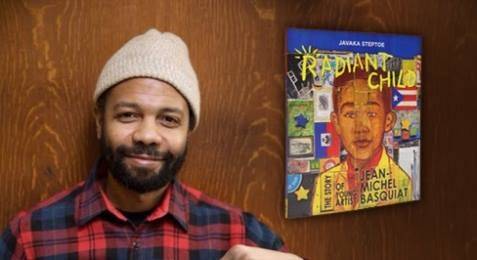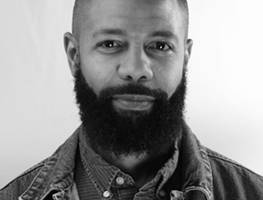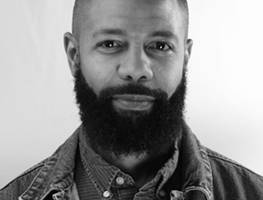I’m under the impression that Javaka Steptoe considers his words carefully while we speak, because he chooses to fill space with silence as opposed to filler words. I was lucky enough to secure a last-minute interview with the most recent Caldecott medal winner just a day or two before he leaves for even more speaking engagements and book festivals. He’ll be in town this Sunday, holding two appearances at Champaign Public Library as a way to wind down Pygmalion Literature Festival.
Steptoe has said in the past that he identifies primarily as a fine artist, who happens to illustrate. His award-winning book – for the most distinguished picture book of 2016, Radiant Child – reframes the narrative surrounding Jean-Michel Basquiat, focusing on how he learned artistic values from his mother and strived to be an artist from a young age. So it makes sense that his late-morning appearance will be a workshop to teach collage techniques to students in 2nd-5th grade. Although you have to reserve a space for your child, there are still places available.
Later in the afternoon, from 2-4 p.m., the artist will be speaking as a way to introduce himself and his past work, share his latest book with images and by reading selections, discussing his process, and taking questions from the audience. Jane Addams Bookshop will be onsite, selling books so they can be signed, allowing for short one-on-one interactions as well. Steptoe observed that even if folks don’t have kids or aren’t necessarily interested in children’s books, they’ll find interesting content within his presentation. “A lot of visual artists and writers like to come and ask great questions about process, breaking into the field, […] or just out of curiosity to hear how artists create.”

While I was researching prior interviews, I noticed that during earlier conversations, Steptoe emphasized his fine arts background – he has illustrated more than a dozen books but only written two – but more recently he has started dropping into conversations that there are stories he is interested in telling. That was interesting to me as a writer, and I wondered if he’s beginning to think more seriously about writing more often.
“I’m definitely looking more at writing. […] Part of it is that, as an illustrator, you have to wait for someone to approach you. I don’t know if I would have gotten Radiant Child if I had waited for it. It didn’t seem like anyone was thinking about writing a book about Basquiat. There’s these ideas and interests that I have, that I’ve explored; these are ideas that I should be writing about. If I’m able to do it, why not do it? Why wait and hope someone has the same idea?”
Even so, no matter how persistent I was, he was reluctant to share any details about his next project. “It’s too early in the process,” he claims.
Even before Radiant Child was announced as the Caldecott medal-winning book, teachers and librarians were championing it, buying it at the store where I work and requesting it from the library. This is an odd and personal conflict for me, because I recognize books as art, and as necessary literacy tools, and as the products of an industry that requires sales to sustain it. As we talked about these forces which are almost oppositional, he observed,
“If you ask a business to branch out and try something new, they look at the budget. What happens usually is that it is left up to the artists, fans, teachers, and librarians to show the business that yes, we can find different ways of marketing and promoting a book, other than the ways that are already set up. It takes creativity, and it takes an investment. [It requires] taking action in terms of expressing a desire for certain types of books, which means buying. Maybe it means writing to your librarians, writing to publishers and saying, ‘These are the types of books we need.’ It’s a situation where people have to speak out and take chances, maybe even writing and publishing the types of books we want to see.”
 A big step forward, however, is writers like Javaka Steptoe who can create a story like Radiant Child which can be both “distinguished” as well as successful. A beautiful and touching story about an artist, a re-framing of a story some think they know inside a larger emotional truth of love, aspiration, and achievement. It’s the kind of story that anyone can hear, and everyone should.
A big step forward, however, is writers like Javaka Steptoe who can create a story like Radiant Child which can be both “distinguished” as well as successful. A beautiful and touching story about an artist, a re-framing of a story some think they know inside a larger emotional truth of love, aspiration, and achievement. It’s the kind of story that anyone can hear, and everyone should.
Javaka Steptoe’s free presentation will happen from 2-4 p.m. in the Robeson Pavilion of Champaign Public Library on Sunday, September 24. Doors open at 1:30 p.m. for book sales, and the maximum capacity is 120 attendees, so I’d recommend planning to be there even a little earlier than that for a special chance to meet and listen to a unique talent making necessary art.








